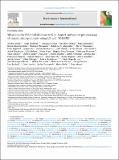Por favor, use este identificador para citar o enlazar a este item:
http://hdl.handle.net/10261/338580COMPARTIR / EXPORTAR:
 SHARE SHARE
 CORE
BASE CORE
BASE
|
|
| Visualizar otros formatos: MARC | Dublin Core | RDF | ORE | MODS | METS | DIDL | DATACITE | |

| Título: | What is in the fish? Collaborative trial in suspect and non-target screening of organic micropollutants using LC- and GC-HRMS |
Autor: | Dürig, Wiebke; Lindblad, Sofia; Golovko, Oksana; Gkotsis, Georgios; Aalizadeh, Reza; Nika, Maria-Christina; Thomaidis, Nikolaos; Alygizakis, Nikiforos A.; Plassmann, Merle; Haglund, Peter; Fu, Qiuguo; Hollender, Juliane; Chaker, Jade; David, Arthur; Kunkel, Uwe; Macherius, André; Belova, Lidia; Poma, Giulia; Preud'Homme, Hugues; Munschy, Catherine; Aminot, Yann; Jaeger, Carsten; Lisec, Jan; Hansen, Martin; Vorkamp, Katrin; Zhu, Linyan; Cappelli, Francesca; Roscioli, Claudio; Valsecchi, Sara; Bagnati, Renzo; González, Belén; Prieto, Ailette; Zuloaga, Olatz; Gil-Solsona, Ruben; Gago-Ferrero, Pablo CSIC ORCID; Rodriguez-Mozaz, Sara; Budzinski, Hélène; Devier, Marie-Helene; Dierkes, Georg; Boulard, Lise; Jacobs, Griet; Voorspoels, Stefan; Rüdel, Heinz; Ahrens, Lutz | Palabras clave: | Suspect and non-target analysis Biota Collaborative trial Exposome GC-HRMS LC-HRMS |
Fecha de publicación: | 25-oct-2023 | Editor: | Elsevier | Citación: | Environment International 181: 108288 (2023) | Resumen: | A collaborative trial involving 16 participants from nine European countries was conducted within the NORMAN network in efforts to harmonise suspect and non-target screening of environmental contaminants in whole fish samples of bream (Abramis brama). Participants were provided with freeze-dried, homogenised fish samples from a contaminated and a reference site, extracts (spiked and non-spiked) and reference sample preparation protocols for liquid chromatography (LC) and gas chromatography (GC) coupled to high resolution mass spectrometry (HRMS). Participants extracted fish samples using their in-house sample preparation method and/or the protocol provided. Participants correctly identified 9-69 % of spiked compounds using LC-HRMS and 20-60 % of spiked compounds using GC-HRMS. From the contaminated site, suspect screening with participants' own suspect lists led to putative identification of on average ∼145 and ∼20 unique features per participant using LC-HRMS and GC-HRMS, respectively, while non-target screening identified on average ∼42 and ∼56 unique features per participant using LC-HRMS and GC-HRMS, respectively. Within the same sub-group of sample preparation method, only a few features were identified by at least two participants in suspect screening (16 features using LC-HRMS, 0 features using GC-HRMS) and non-target screening (0 features using LC-HRMS, 2 features using GC-HRMS). The compounds identified had log octanol/water partition coefficient (KOW) values from -9.9 to 16 and mass-to-charge ratios (m/z) of 68 to 761 (LC-HRMS and GC-HRMS). A significant linear trend was found between log KOW and m/z for the GC-HRMS data. Overall, these findings indicate that differences in screening results are mainly due to the data analysis workflows used by different participants. Further work is needed to harmonise the results obtained when applying suspect and non-target screening approaches to environmental biota samples. | Versión del editor: | https://doi.org/10.1016/j.envint.2023.108288 | URI: | http://hdl.handle.net/10261/338580 | DOI: | 10.1016/j.envint.2023.108288 | ISSN: | 01604120 |
| Aparece en las colecciones: | (IDAEA) Artículos |
Ficheros en este ítem:
| Fichero | Descripción | Tamaño | Formato | |
|---|---|---|---|---|
| 1-s2.0-S0160412023005615-main.pdf | Artículo principal | 3,67 MB | Adobe PDF |  Visualizar/Abrir |
| ScienceDirect_files_08Nov2023_09-36-00.983.zip | Material suplementario | 4,4 MB | Unknown | Visualizar/Abrir |
CORE Recommender
Page view(s)
27
checked on 14-may-2024
Download(s)
29
checked on 14-may-2024
Google ScholarTM
Check
Altmetric
Altmetric
NOTA: Los ítems de Digital.CSIC están protegidos por copyright, con todos los derechos reservados, a menos que se indique lo contrario.


